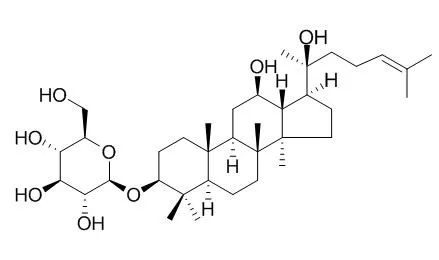| Description: |
Ginsenoside Rh2 has memory-enhancing ,anti-osteoporosis, antitumor, antidiabetic, antiallergic, and anti-inflammatory effects, it potently protects ischemia-reperfusion brain injury, also inhibits prostaglandin-E_2 synthesis in lipopolysaccharide-stimulated RAW264.7 cells. It can inhibit the tendency of apoptosis, and reverse the impaired β-cell growth potential by modulating Akt/Foxo1/PDX-1 signaling pathway and regulating cell cycle proteins; it suppresses RANKL-induced osteoclast differentiation in vitro and in vivo through the regulation of c-Fos and NFATc1 expressions, not excluding the involvement of NF-κB and ERK. |
| In vitro: |
| Xi Bao Yu Fen Zi Mian Yi Xue Za Zhi. 2014 Oct;30(10):1062-6. | | [Regulatory effect of ginsenoside Rh2 on HDAC1/2 activity and cyclin in human erythroleukemia K562 cells].[Pubmed: 25270209] | To investigate the effects of the 20(S)-Ginsenoside Rh2 [Rh2(S)]on cell proliferation, histone deacetylase 1 (HDAC1) and HDAC2 activity, and expression of cyclin in human erythroleukemia K562 cells.
METHODS AND RESULTS:
The proliferation of K562 cells was inhibited by 20(S)-Ginsenoside Rh2 (20-80 μmol/L) in dose-and time-dependent manner. FCM analyses revealed that the number of the K562 cells treated with 60 μmol/L 20(S)-Ginsenoside Rh2 was arrested in G0/G1 phase. The apoptosis rates of K562 cells were respectively (8.09±0.86)%, (9.44±0.53)% and (22.80±2.16)% after induced by 20, 40, 60 μmol/L 20(S)-Ginsenoside Rh2, which showed statistically significant difference (P<0.05) compared with the control group (2.63±0.14)%. HDAC activity of the cells treated with 20(S)-Ginsenoside Rh2 (40, 60 μmol/L) was reduced. Western blotting showed that the expressions of HDAC1, HDAC2, cyclin D1 and CDK4 decreased after induced by 20(S)-Ginsenoside Rh2, and p16INK4A, p21 proteins were enhanced significantly.
CONCLUSIONS:
The 20(S)-Ginsenoside Rh2 can inhibit the proliferation of K562 cells and induce its cycle arrest and apoptosis through inhibiting HDAC1 and HDAC2 activity, down-regulating the expression of cyclin D1 and activating p16INK4A and p21. | | Biol Pharm Bull. 2014;37(2):248-54. | | 20S-Ginsenoside Rh2 induces apoptosis in human Leukaemia Reh cells through mitochondrial signaling pathways.[Pubmed: 24492721] | 20(S)-Ginsenoside Rh2 (GRh2) and ginsenoside Rg3 (GRg3) are members of the protopanaxadiol family and have been investigated for possible chemopreventive activity. This study explored the biological and apoptotic mechanisms induced by 20(S)-GRh2 in human acute leukaemia line-Reh cells.
METHODS AND RESULTS:
Reh cells were treated with different concentration of 20(S)-Ginsenoside Rh2 in vitro. Cell viability was determined by Cell Counting Kit-8 and Annexin V/7-AAD assays. Mitochondrial membrane potential (MMP) was examined through JC-1 staining. Activation of caspases associated with the mitochondria-mediated apoptosis pathway was determined by Western blot. We observed that survival of Reh cells decreased after exposure to 20(S)-Ginsenoside Rh2 in a concentration-dependent manner. Moreover,20(S)-Ginsenoside Rh2 can induce mitochondria depolarization of Reh cells as evident in the shift in JC-1 fluorescence from red to green. In addition, 20(S)-Ginsenoside Rh2 induced the release of mitochondrial cytochrome c and activation of caspase-9 and caspase-3 in Reh cells.
CONCLUSIONS:
These results indicate that 20(S)-Ginsenoside Rh2 could induce apoptosis through the mitochondrial pathway, demonstrating its potential as a chemotherapeutic agent for leukaemia therapy. |
|






 Cell. 2018 Jan 11;172(1-2):249-261.e12. doi: 10.1016/j.cell.2017.12.019.IF=36.216(2019)
Cell. 2018 Jan 11;172(1-2):249-261.e12. doi: 10.1016/j.cell.2017.12.019.IF=36.216(2019) Cell Metab. 2020 Mar 3;31(3):534-548.e5. doi: 10.1016/j.cmet.2020.01.002.IF=22.415(2019)
Cell Metab. 2020 Mar 3;31(3):534-548.e5. doi: 10.1016/j.cmet.2020.01.002.IF=22.415(2019) Mol Cell. 2017 Nov 16;68(4):673-685.e6. doi: 10.1016/j.molcel.2017.10.022.IF=14.548(2019)
Mol Cell. 2017 Nov 16;68(4):673-685.e6. doi: 10.1016/j.molcel.2017.10.022.IF=14.548(2019)